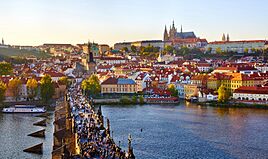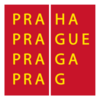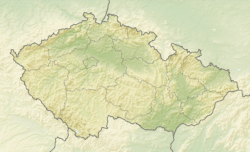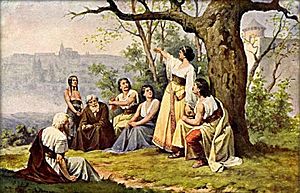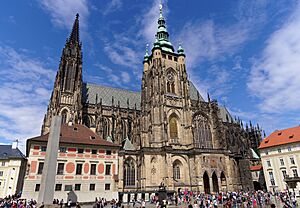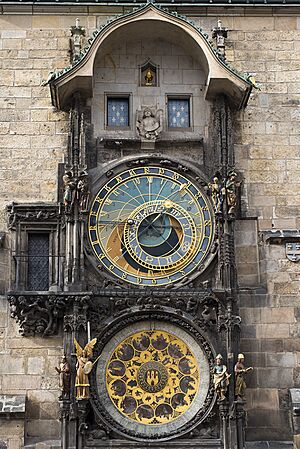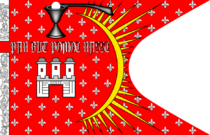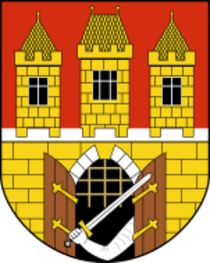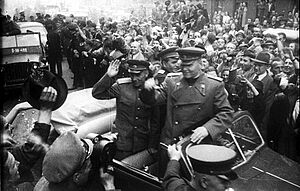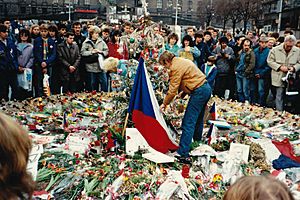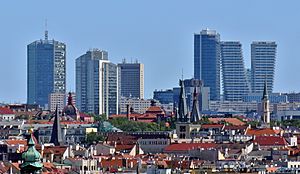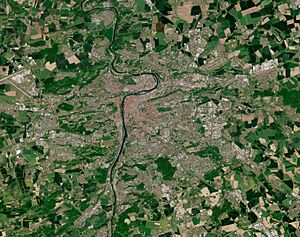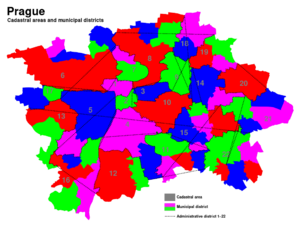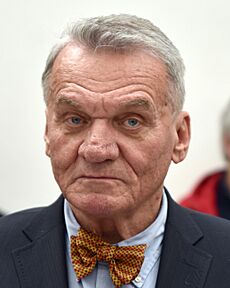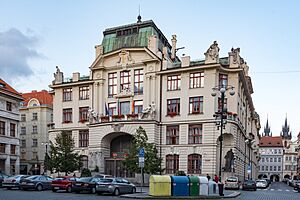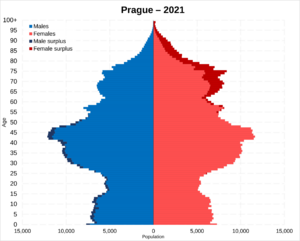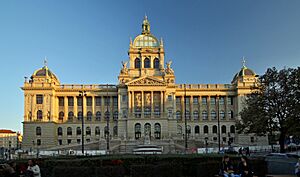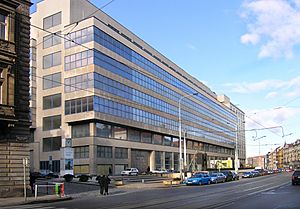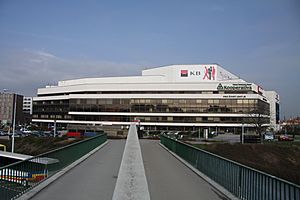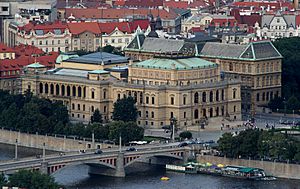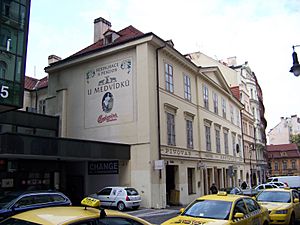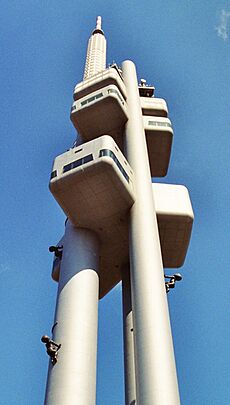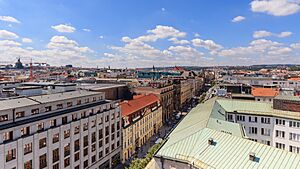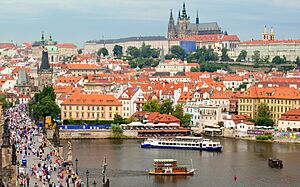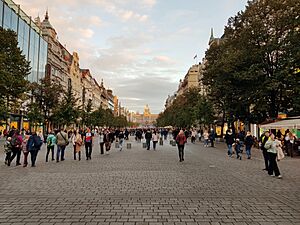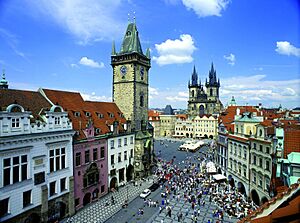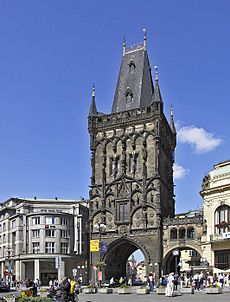Prague facts for kids
Quick facts for kids
Prague
Praha (Czech)
|
|||||
|---|---|---|---|---|---|
|
|
|||||
|
|||||
| Nickname(s):
City of a Hundred Spires
|
|||||
| Motto(s): | |||||
| Country | |||||
| Founded | 8th century | ||||
| Area | |||||
| • Capital city | 496.21 km2 (191.59 sq mi) | ||||
| • Urban | 298 km2 (115 sq mi) | ||||
| • Metro | 11,425 km2 (4,411 sq mi) | ||||
| Highest elevation | 399 m (1,309 ft) | ||||
| Lowest elevation | 172 m (564 ft) | ||||
| Population
(2024-01-01)
|
|||||
| • Capital city | 1,384,732 | ||||
| • Density | 2,790.617/km2 (7,227.66/sq mi) | ||||
| • Metro | 2,267,817 | ||||
| • Metro density | 237/km2 (610/sq mi) | ||||
| Demonym(s) | Praguer, Pragueite | ||||
| GDP | |||||
| • Capital city | €78.414 billion (2022) | ||||
| • Metro | €109.990 billion (2022) | ||||
| • Per capita (city) | €59,404 (2022) | ||||
| Time zone | UTC+1 (CET) | ||||
| • Summer (DST) | UTC+2 (CEST) | ||||
| Postal codes |
100 00 – 199 00
|
||||
| ISO 3166 code | CZ-10 | ||||
| Vehicle registration | A, AA – AZ | ||||
| HDI (2021) | 0.960 – very high · 1st | ||||
Prague (pronounced PRAHG) is the capital and largest city of the Czech Republic. It is also the historical capital of Bohemia. Prague sits on the Vltava river and is home to about 1.4 million people. The city has a mild climate, with warm summers and cool winters.
Prague is a major center for politics, culture, and business in Central Europe. It has a rich history and amazing buildings. You can see Romanesque, Gothic, Renaissance, and Baroque styles. Prague was once the capital of the Kingdom of Bohemia. It was also home to several Holy Roman Emperors, like Charles IV.
The city was important to the Habsburg monarchy and Austria-Hungary. Prague played a big part in the Bohemian and Protestant Reformations. It was also involved in the Thirty Years' War. In the 20th century, it was the capital of Czechoslovakia after the World Wars. It remained so during the Communist era.
Prague has many famous places to visit. These include Prague Castle, Charles Bridge, and Old Town Square. The square has the amazing Prague astronomical clock. Other sights are the Jewish Quarter, Petřín hill, and Vyšehrad. Since 1992, Prague's historic center has been a UNESCO World Heritage Site.
The city has over ten major museums. There are also many theaters, galleries, and cinemas. A large public transportation system helps people get around. Prague is home to many schools, including Charles University. This is the oldest university in Central Europe.
Prague is known as an "Alpha-" global city. This means it's a very important city worldwide. In 2019, it was ranked as the 13th most livable city. Its long history makes it a popular place for tourists. Over 8.5 million international visitors come each year. In 2017, Prague was the fifth most visited European city.
Contents
- Understanding Prague's Name
- Prague's Long History
- Prague's Geography
- How Prague is Governed
- People of Prague
- Prague's Culture and Arts
- Prague's Economy
- Tourism in Prague
- Education in Prague
- Science and Research in Prague
- Getting Around Prague: Transport
- Sports in Prague
- Prague's International Connections
- See also
Understanding Prague's Name
The Czech name Praha comes from an old Slavic word. This word, práh, means "ford" or "rapid". It refers to how the city started at a river crossing point.
Another idea for the name's origin also relates to the Czech word práh. This word can also mean "threshold". A legend says that Princess Libuše ordered the city to be built. She said it should be "where a man hews a threshold of his house". So, práh might mean a river crossing that acted like a "threshold" to the castle.
Some people think the name Praha comes from na prazě. This was the original name for the shale rock. The first castle was built on this hillside rock. Back then, forests covered the nine hills of the future city. The Old Town and Lesser Town came later.
The English spelling "Prague" comes from French. In the past, it was sometimes pronounced to rhyme with "vague".
Prague is often called the "City of a Hundred Spires". A mathematician counted them in the 1800s. Today, the Prague Information Service estimates there are 500 spires. Other nicknames include: the Golden City, the Mother of Cities, and the Heart of Europe.
Prague's Long History
Prague grew from a small settlement. It stretched from Prague Castle in the north to Vyšehrad fort in the south. Today, it is the capital of a modern European country.
Early Beginnings of Prague
People lived in this area as far back as the Paleolithic age. Some old writings say the city was founded around 1306 BC.
Around 400-500 BC, a Celtic tribe called the Boii lived here. They built settlements, including a large one called Závist. They named the region Bohemia, meaning "home of the Boii people". Later, Germanic tribes moved in.
In the late 400s AD, Germanic tribes moved west. Then, in the 500s, Slavic tribes settled in Central Bohemia. Over the next 300 years, Czech tribes built many fortified places.
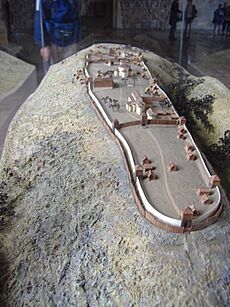
Building Prague Castle started around the late 800s. It grew from an older fortified settlement. The first stone parts of Prague Castle date back to 885. The other main fort, Vyšehrad, was built in the 900s. The huge cathedral at Prague Castle began in 1344. It was not finished until the 1900s.
Legends say that Prague was founded by Princess Libuše. She was an 8th-century Czech duchess and prophetess. She and her husband, Přemysl, started the Přemyslid dynasty. The legend says Libuše stood on a cliff above the Vltava river. She said, "I see a great city whose glory will touch the stars." She ordered a castle and a town called Praha to be built there.
The region became the home of the dukes and later kings of Bohemia. Prague became a bishopric in 973. This happened under Duke Boleslaus II.
Prague was an important trading center. Merchants from all over Europe came here. Many Jewish people settled here, as noted in 965. The Old New Synagogue from 1270 is still in the city.
In 1170, King Vladislaus I built the first bridge. It was called the Judith Bridge. A flood destroyed it in 1342. Later, the Charles Bridge was built in its place.
In 1257, King Ottokar II founded Malá Strana. This "Lesser Quarter" was for German people. They had their own laws. It was across the river from the Staré Město ("Old Town"). The Old Town had walls and defenses.
Prague in the Middle Ages
Prague grew a lot during the 1300s. This was when Charles IV was king (1346–1378). He was King of Bohemia and Holy Roman Emperor. He made Prague an imperial capital. By the 1470s, Prague had about 70,000 people. It was the third-largest city in the Holy Roman Empire.
Charles IV ordered the building of the New Town. He designed it himself. The Charles Bridge was built to connect the city parts. In 1347, he started Charles University. It is the oldest university in Central Europe.
His father, John of Bohemia, began building the Gothic St. Vitus Cathedral. Prague became an archbishopric in 1344.
The city had a mint for making coins. It was a trade center for bankers and merchants. However, there were also problems. The power of craftsmen's guilds grew. There were also more poor people.
The Hunger Wall was built in the 1360s during a famine. Charles IV ordered it to give jobs and food to people.
Charles IV died in 1378. His son, King Wenceslaus IV, ruled next. This was a time of trouble. In 1389, mobs attacked the Jewish quarter. Almost all 3,000 Jewish people in Prague were killed.
Jan Hus, a professor at Charles University, preached in Prague. He spoke about changes for the Church. His ideas were seen as dangerous. Hus was tried for heresy and burned at the stake in 1415.
Four years later, Prague had its first defenestration. People rebelled under Jan Želivský. Hus's death led to the Hussite Wars. Hussite troops from Prague defeated Emperor Sigismund in 1420.
During the Hussite Wars, Prague was attacked. The city's fighters bravely defended it. They used a special flag called the Prague Banner. This flag was red with white fleurs-de-lis. It had the city's coat-of-arms in the center. It also said "The Lord is our Relief/Help." This flag is the oldest preserved city flag of Bohemia.
For the next two centuries, Prague became a stronger trading city. Many beautiful Gothic buildings were built. The Vladislav Hall was added to Prague Castle.
The Habsburg Era in Prague
In 1526, the Bohemian nobles chose Ferdinand I to be their king. He was from the House of Habsburg. The Habsburgs were very Catholic. This caused problems in Prague, where Protestant ideas were popular.
Things were calmer under Emperor Rudolf II. He became King of Bohemia in 1576. He chose Prague as his home. His court at Prague Castle welcomed scientists, musicians, and artists. Rudolf loved art, and Prague became a center of European culture. Famous people like astronomers Tycho Brahe and Johannes Kepler lived there.
In 1618, the famous second defenestration of Prague happened. This event started the Thirty Years' War. This was a very hard time for Prague and Bohemia. Ferdinand II was removed as king. His army was defeated in the Battle of White Mountain in 1620. After this, 27 Czech Protestant leaders were executed in Old Town Square. Many others were forced to leave. Prague was made Catholic again.
The city suffered during the war. Its population dropped from 60,000 to 20,000. In the late 1600s, Prague's population started to grow again. Jewish people had lived in Prague since the 900s. By 1708, they made up about a quarter of the city's population.
In 1689, a big fire destroyed much of Prague. But this led to the city being rebuilt and improved. In 1713–14, a major plague hit Prague. It killed 12,000 to 13,000 people.
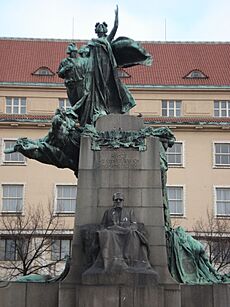
In 1744, Frederick the Great of Prussia attacked Bohemia. He took Prague after a long siege. Much of the city was destroyed. Empress Maria Theresa forced Jewish people out of Prague in 1745. She later allowed them back, but their numbers never fully recovered. In 1757, Prussian bombs destroyed over a quarter of the city. St. Vitus Cathedral was badly damaged.
Prague's economy got better in the 1700s. The population grew to 80,000 by 1771. Rich merchants and nobles built many beautiful palaces, churches, and gardens. They filled them with art and music. This made Prague a famous Baroque city.
In 1784, four parts of Prague were joined into one city. These were Malá Strana, Nové Město, Staré Město, and Hradčany. The Jewish district, Josefov, was added in 1850. The Industrial Revolution brought big changes. New factories used coal and iron from nearby areas. The first suburb, Karlín, was created in 1817. Twenty years later, the population was over 100,000.
The Revolutions of 1848 also affected Prague. But they were put down. In the years after, the Czech National Revival began. This was a movement to celebrate Czech culture and language. By 1861, Czech speakers had the majority in the city council. The number of German speakers in Prague decreased a lot. This was because many Czechs moved to the city.
Prague in the 20th Century
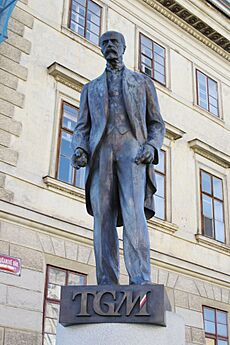
First Czechoslovak Republic
World War I ended with the defeat of the Austro-Hungarian Empire. This led to the creation of Czechoslovakia. Prague was chosen as its capital. Tomáš Garrigue Masaryk became the first president. Prague Castle became his home. At this time, Prague was a major European capital with strong industries. By 1930, the population reached 850,000.
World War II in Prague
Hitler's German Army entered Prague on 15 March 1939. From Prague Castle, Hitler declared Bohemia and Moravia a German protectorate. Prague had always been a city with Czech, German, and Jewish people. During Second World War, most Jewish people were sent away and killed by the Germans.
In 1942, Reinhard Heydrich, a powerful Nazi leader, was killed in Prague. This was part of Operation Anthropoid. Czechoslovak heroes Jozef Gabčík and Jan Kubiš carried it out. Hitler ordered harsh revenge.
In February 1945, Prague was bombed by the US Army Air Forces. 701 people died, and over 1,000 were hurt. Some buildings were destroyed. However, many historic structures in Prague survived the war. The damage was small compared to other cities. American pilots said it was a navigation mistake. In March, military factories were bombed, killing about 370 people.
On 5 May 1945, an uprising against Germany began. Thousands of Czechs died in street fights. On 9 May, the Red Army took the city. Most of Prague's German population either fled or were forced out after the war.
Prague During the Cold War
Prague was part of a country controlled by the Soviet Union. The world's largest Stalin Monument was built in 1955. It was destroyed in 1962.
In June 1967, writers in Prague spoke out against the government. Students protested in October 1967. This led to Alexander Dubček starting the "socialism with a human face" movement. This was called the Prague Spring. It aimed to make political changes in a democratic way. But other Warsaw Pact countries, led by the Soviet Union, stopped these changes. They invaded Czechoslovakia and Prague on 21 August 1968. This invasion ended the reforms. The Soviet military stayed in Czechoslovakia until 1991.
Prague After the Velvet Revolution
In 1989, a peaceful student protest was stopped by police. This led to the Velvet Revolution in Prague. The capital of Czechoslovakia changed a lot. In 1992, the Historic Centre of Prague became a UNESCO World Heritage Site. In 1993, after the "Velvet Divorce," Prague became the capital of the new Czech Republic.
From 1995, many tall buildings were built in Prague. By the late 1990s, Prague was again a major cultural center in Europe. It was influenced by globalisation. In 2000, big international meetings happened in Prague. There were also protests. In 2002, Prague had widespread floods. These damaged buildings and the subway.
Prague tried to host the 2016 Summer Olympics, but it didn't make the final list. In 2009, due to money problems, Prague canceled its plan to bid for the 2020 Summer Olympics.
Prague's Geography
Prague is located on the Vltava river. The Berounka river flows into the Vltava in the suburbs. There are 99 waterways in Prague, totaling 340 km (211 miles). The longest streams are Rokytka and Botič.
The city has 3 reservoirs, 37 ponds, and 34 water storage areas. The largest pond is Velký Počernický. The biggest body of water is Hostivař Reservoir.
Most of Prague is on the Prague Plateau. The highest point is Teleček hill, at 399 meters (1,309 ft) above sea level. Important hills in the city center are Petřín (327 m/1,073 ft) and Vítkov (270 m/886 ft). The lowest point is the Vltava river in Suchdol, at 172 meters (564 ft).
Prague is located at about 50°5′N 14°25′E. This is similar to the latitude of Frankfurt, Germany, and Paris, France.
Prague's Climate
Prague has an oceanic climate. Winters are quite cold, with temperatures around freezing (0 °C/32 °F). There is little sunshine. Snow can be common from mid-November to late March. Summers are usually sunny, with average high temperatures of 24 °C (75 °F). Nights can be cool even in summer.
Prague gets a moderate amount of rain, about 500-600 mm (20-24 inches) per year. This is because it is in the rain shadow of mountains. Winter is usually the driest season. Late spring and summer can have heavy rain, especially thunderstorms. Prague is also a windy city. Winds often help clear the air in colder months.
| Climate data for Václav Havel Airport, Prague Coordinates 50°06′01″N 14°15′20″E / 50.10028°N 14.25556°E; elevation: 364 m (1,194 ft); WMO ID: 11518; 1991–2020 normals, extremes 1933–present |
|||||||||||||
|---|---|---|---|---|---|---|---|---|---|---|---|---|---|
| Month | Jan | Feb | Mar | Apr | May | Jun | Jul | Aug | Sep | Oct | Nov | Dec | Year |
| Record high °C (°F) | 15.8 (60.4) |
19.2 (66.6) |
24.1 (75.4) |
29.7 (85.5) |
33.0 (91.4) |
36.7 (98.1) |
36.8 (98.2) |
37.4 (99.3) |
32.8 (91.0) |
27.8 (82.0) |
19.5 (67.1) |
17.8 (64.0) |
37.4 (99.3) |
| Mean daily maximum °C (°F) | 1.8 (35.2) |
3.7 (38.7) |
8.4 (47.1) |
14.5 (58.1) |
18.9 (66.0) |
22.2 (72.0) |
24.5 (76.1) |
24.4 (75.9) |
19.1 (66.4) |
12.9 (55.2) |
6.5 (43.7) |
2.7 (36.9) |
13.3 (55.9) |
| Daily mean °C (°F) | −0.7 (30.7) |
0.3 (32.5) |
4.0 (39.2) |
9.2 (48.6) |
13.6 (56.5) |
17.0 (62.6) |
18.9 (66.0) |
18.7 (65.7) |
13.9 (57.0) |
8.7 (47.7) |
3.8 (38.8) |
0.4 (32.7) |
9.0 (48.2) |
| Mean daily minimum °C (°F) | −3.5 (25.7) |
−3.0 (26.6) |
0.0 (32.0) |
3.6 (38.5) |
7.8 (46.0) |
11.3 (52.3) |
13.1 (55.6) |
12.9 (55.2) |
9.1 (48.4) |
4.9 (40.8) |
1.0 (33.8) |
−2.2 (28.0) |
4.6 (40.3) |
| Record low °C (°F) | −25.5 (−13.9) |
−28.0 (−18.4) |
−19.0 (−2.2) |
−8.7 (16.3) |
−5.0 (23.0) |
−0.6 (30.9) |
5.0 (41.0) |
3.4 (38.1) |
−0.6 (30.9) |
−8.1 (17.4) |
−13.4 (7.9) |
−23.5 (−10.3) |
−28.0 (−18.4) |
| Average precipitation mm (inches) | 20.2 (0.80) |
18.2 (0.72) |
29.2 (1.15) |
27.5 (1.08) |
60.3 (2.37) |
73.1 (2.88) |
79.2 (3.12) |
67.2 (2.65) |
38.5 (1.52) |
34.2 (1.35) |
28.5 (1.12) |
25.9 (1.02) |
502.1 (19.77) |
| Average snowfall cm (inches) | 14.3 (5.6) |
13.1 (5.2) |
7.0 (2.8) |
0.8 (0.3) |
0.0 (0.0) |
0.0 (0.0) |
0.0 (0.0) |
0.0 (0.0) |
0.0 (0.0) |
0.2 (0.1) |
4.5 (1.8) |
10.0 (3.9) |
49.9 (19.6) |
| Average precipitation days (≥ 1.0mm) | 6.0 | 5.6 | 6.7 | 6.2 | 9.2 | 9.8 | 9.9 | 9.0 | 7.1 | 7.0 | 6.6 | 6.2 | 89.3 |
| Average relative humidity (%) | 84.8 | 80.0 | 74.7 | 66.6 | 68.2 | 69.2 | 67.4 | 68.0 | 74.9 | 81.5 | 86.7 | 86.0 | 75.7 |
| Average dew point °C (°F) | −4.6 (23.7) |
−3.5 (25.7) |
−1.1 (30.0) |
2.0 (35.6) |
7.0 (44.6) |
10.3 (50.5) |
11.6 (52.9) |
11.5 (52.7) |
9.1 (48.4) |
5.1 (41.2) |
0.6 (33.1) |
−2.8 (27.0) |
3.8 (38.8) |
| Mean monthly sunshine hours | 57.3 | 89.5 | 132.5 | 196.0 | 230.9 | 235.8 | 242.7 | 231.4 | 169.5 | 112.7 | 57.2 | 48.1 | 1,804 |
| Average ultraviolet index | 1 | 1 | 3 | 4 | 6 | 7 | 6 | 6 | 4 | 2 | 1 | 1 | 4 |
| Source 1: NOAA (dew point 1961-1990) | |||||||||||||
| Source 2: Czech Hydrometeorological Institute (humidity and snowfall 1991-2020, extremes) and Weather Atlas | |||||||||||||
| Climate data for Clementinum, Prague; WMO ID: 11515; extremes 1775–present | |||||||||||||
|---|---|---|---|---|---|---|---|---|---|---|---|---|---|
| Month | Jan | Feb | Mar | Apr | May | Jun | Jul | Aug | Sep | Oct | Nov | Dec | Year |
| Record high °C (°F) | 17.4 (63.3) |
18.5 (65.3) |
22.9 (73.2) |
30.7 (87.3) |
32.8 (91.0) |
37.7 (99.9) |
37.8 (100.0) |
36.8 (98.2) |
33.1 (91.6) |
27.8 (82.0) |
19.5 (67.1) |
17.7 (63.9) |
37.8 (100.0) |
| Mean daily maximum °C (°F) | 3.9 (39.0) |
5.6 (42.1) |
10.0 (50.0) |
16.1 (61.0) |
20.9 (69.6) |
24.4 (75.9) |
26.5 (79.7) |
25.9 (78.6) |
20.4 (68.7) |
14.4 (57.9) |
8.5 (47.3) |
4.8 (40.6) |
15.1 (59.2) |
| Daily mean °C (°F) | 1.8 (35.2) |
2.9 (37.2) |
6.5 (43.7) |
11.7 (53.1) |
16.2 (61.2) |
19.7 (67.5) |
21.6 (70.9) |
21.1 (70.0) |
16.2 (61.2) |
11.0 (51.8) |
6.3 (43.3) |
2.8 (37.0) |
11.5 (52.7) |
| Mean daily minimum °C (°F) | −0.5 (31.1) |
0.0 (32.0) |
2.9 (37.2) |
6.9 (44.4) |
11.3 (52.3) |
14.8 (58.6) |
16.6 (61.9) |
16.3 (61.3) |
12.2 (54.0) |
7.9 (46.2) |
3.9 (39.0) |
0.6 (33.1) |
7.7 (45.9) |
| Record low °C (°F) | −27.5 (−17.5) |
−27.1 (−16.8) |
−27.6 (−17.7) |
−8.0 (17.6) |
−1.6 (29.1) |
3.6 (38.5) |
7.8 (46.0) |
6.4 (43.5) |
0.7 (33.3) |
−7.5 (18.5) |
−16.9 (1.6) |
−24.8 (−12.6) |
−27.6 (−17.7) |
| Average precipitation mm (inches) | 18.1 (0.71) |
16.2 (0.64) |
26.3 (1.04) |
24.7 (0.97) |
58.1 (2.29) |
68.6 (2.70) |
67.4 (2.65) |
61.9 (2.44) |
33.9 (1.33) |
29.8 (1.17) |
26.2 (1.03) |
22.6 (0.89) |
453.9 (17.87) |
| Average snowfall cm (inches) | 5.8 (2.3) |
4.2 (1.7) |
1.6 (0.6) |
0.0 (0.0) |
0.0 (0.0) |
0.0 (0.0) |
0.0 (0.0) |
0.0 (0.0) |
0.0 (0.0) |
0.0 (0.0) |
0.8 (0.3) |
3.6 (1.4) |
16.1 (6.3) |
| Average relative humidity (%) | 76.2 | 71.2 | 65.9 | 58.7 | 58.9 | 59.3 | 58.7 | 60.5 | 67.7 | 73.5 | 77.4 | 76.7 | 67.1 |
| Mean monthly sunshine hours | 52.4 | 81.9 | 129.3 | 187.8 | 216.3 | 218.4 | 229.1 | 224.1 | 168.2 | 110.8 | 52.5 | 46.2 | 1,716.9 |
| Source: Czech Hydrometeorological Institute | |||||||||||||
| Climate data for Prague (extremes 1961-2020) | |||||||||||||
|---|---|---|---|---|---|---|---|---|---|---|---|---|---|
| Month | Jan | Feb | Mar | Apr | May | Jun | Jul | Aug | Sep | Oct | Nov | Dec | Year |
| Record high °C (°F) | 17.2 (63.0) |
19.5 (67.1) |
24.1 (75.4) |
30.4 (86.7) |
33.0 (91.4) |
38.5 (101.3) |
40.2 (104.4) |
39.6 (103.3) |
33.7 (92.7) |
26.6 (79.9) |
19.3 (66.7) |
17.8 (64.0) |
40.2 (104.4) |
| Record low °C (°F) | −25.5 (−13.9) |
−22.5 (−8.5) |
−19.0 (−2.2) |
−7.2 (19.0) |
−2.4 (27.7) |
−0.6 (30.9) |
5.0 (41.0) |
3.4 (38.1) |
−0.5 (31.1) |
−8.2 (17.2) |
−13.4 (7.9) |
−23.5 (−10.3) |
−25.5 (−13.9) |
| Source 1: CHMI | |||||||||||||
| Source 2: NCEI | |||||||||||||
How Prague is Governed
Prague's Administrative Divisions
Prague is the capital of the Czech Republic. It is where the main government offices are located. Since 1990, Prague has been both a city and a region. It also hosts offices for the Central Bohemian Region.
Before 1949, Prague's districts were based on whole towns or areas. After 1949, the way Prague was divided changed. Now, the boundaries of many districts are different from the old land areas. Some land areas are even split into different parts of the city. These old land areas are still used for registering land and houses.
Prague is divided into 10 main municipal districts (1–10). It also has 22 administrative districts (1–22). There are 57 municipal parts and 112 cadastral areas.
People of Prague
Population Numbers
In 2011, the official population of Prague was about 1.3 million. However, the real number is much higher. Only 65% of people said they lived there permanently. Data from mobile phones suggests Prague's real population is closer to 1.9 or 2.0 million. An extra 300,000 to 400,000 people come to the city for work or school on weekdays.
About 14% of people in Prague were born outside the Czech Republic. This is the highest percentage in the country. However, 64.8% of people said they were ethnically Czech. The largest minority groups are Slovaks, Ukrainians, and Russians.
Prague's population is the oldest and most educated in the Czech Republic. It has the fewest children. Only 10.8% of people said they belonged to a religion. Most of these were Roman Catholics.
Historical Population Growth
Here's how Prague's population has changed over time:
| Historical population | ||||||||||||||||||||||||||||||||||||||||||||||||||||||||||||||||||||||||||
|---|---|---|---|---|---|---|---|---|---|---|---|---|---|---|---|---|---|---|---|---|---|---|---|---|---|---|---|---|---|---|---|---|---|---|---|---|---|---|---|---|---|---|---|---|---|---|---|---|---|---|---|---|---|---|---|---|---|---|---|---|---|---|---|---|---|---|---|---|---|---|---|---|---|---|
|
|
|
||||||||||||||||||||||||||||||||||||||||||||||||||||||||||||||||||||||||
People from Other Countries in Prague
As of March 2023, there were 325,336 foreign residents in Prague. Here are the most common nationalities:
| Foreign residents in Prague (March 2023) | |||||||||||||||||||||||||||||||||||||||||||||||||||||||||
| Nationality | Population | ||||||||||||||||||||||||||||||||||||||||||||||||||||||||
|---|---|---|---|---|---|---|---|---|---|---|---|---|---|---|---|---|---|---|---|---|---|---|---|---|---|---|---|---|---|---|---|---|---|---|---|---|---|---|---|---|---|---|---|---|---|---|---|---|---|---|---|---|---|---|---|---|---|
| 147,701 | |||||||||||||||||||||||||||||||||||||||||||||||||||||||||
| 31,074 | |||||||||||||||||||||||||||||||||||||||||||||||||||||||||
| 27,130 | |||||||||||||||||||||||||||||||||||||||||||||||||||||||||
| 15,245 | |||||||||||||||||||||||||||||||||||||||||||||||||||||||||
|
|||||||||||||||||||||||||||||||||||||||||||||||||||||||||
Prague's Culture and Arts
| UNESCO World Heritage Site | |
|---|---|
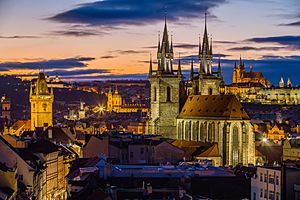 |
|
| Includes | Historic Centre of Prague and Průhonice Park |
| Criteria | Cultural: ii, iv, vi |
| Inscription | 1992 (16th Session) |
| Area | 1,106.36 ha |
| Buffer zone | 9,887.09 ha |
Prague is famous for its culture. It hosts many cultural events. Important places include the National Theatre and the Estates Theatre. Famous operas by Mozart first played at the Estates Theatre. The Rudolfinum is home to the Czech Philharmonic Orchestra. The Municipal House hosts the Prague Symphony Orchestra. The Prague State Opera performs at the Smetana Theatre.
The city has many world-class museums. These include the National Museum and the Jewish Museum in Prague. You can also find the Alfons Mucha Museum and the Museum of Decorative Arts in Prague. The National Gallery has the largest art collection in the Czech Republic.
Prague has hundreds of concert halls, galleries, and cinemas. It hosts many music festivals. These include the Prague Spring International Music Festival. Film festivals like Febiofest also take place here. The city also hosts the Prague Writers' Festival and the Summer Shakespeare Festival.
With more low-cost airlines, Prague has become a popular weekend trip. Tourists visit its museums and cultural sites. They also enjoy Czech beers and food.
The city has many buildings designed by famous architects. These include Adolf Loos and Frank O. Gehry.
Recent big events in Prague:
- International Monetary Fund and World Bank Summit 2000
- NATO Summit 2002
- International Olympic Committee Session 2004
- IAU General Assembly 2006 (defined what a planet is)
- EU & USA Summit 2009
- Czech Presidency of the Council of the European Union 2009
- USA & Russia Summit 2010 (signed the New START treaty)
Prague's Delicious Food
In 2008, the Allegro restaurant in Prague got the first Michelin star in Central Europe. As of 2022, Prague has 27 Michelin-starred restaurants.
Czech beer has a long history. Brewing started in Břevnov Monastery in 993. In the Old Town, Žižkov, and Vinohrady, there are many restaurants and pubs. They often serve Czech beer. Prague also hosts several microbrewery festivals. Historic breweries include Staropramen and U Fleků.
Prague's Economy
Prague's economy makes up 25% of the Czech Republic's total economy. This makes it the strongest region in the country. In 2021, its economic output per person was very high. It was the third best-performing region in the EU.
Prague employs almost one-fifth of all Czech workers. Wages in Prague are much higher than the national average. In late 2020, average salaries were about €1,800 per month. Since 1990, Prague's economy has changed. It moved from industry to services. Industries include medicine, printing, food, and computer technology. Services like finance, trade, and tourism are very important. Services make up about 80% of jobs.
There are 800,000 employees in Prague. This includes 120,000 people who travel to work there. The number of foreign residents working in Prague has grown. About one-fifth of all money invested in the Czech Republic goes to Prague.
Almost half of the country's income from tourism is spent in Prague. The city has about 73,000 beds for visitors. Most of these were built after 1990.
From the late 1990s to the late 2000s, Prague was a popular place for filming movies. Its beautiful buildings, lower costs, and film industry made it attractive.
Prague's modern economy is based on services and exports. In 2010, it was named the best city in Central and Eastern Europe for business.
In 2005, Prague was ranked among the top three cities in Central and Eastern Europe for livability. In 2010, it was ranked 29th globally for innovation. This was ahead of cities like Brussels.
Na příkopě is the most expensive street among the V4 countries. In 2017, it was the 22nd most expensive street in the world for rent. Pařížská street is the second most expensive.
In a Eurostat study, Prague ranked fifth among Europe's 271 regions for economic output per person. It was higher than Paris.
Companies with the highest sales in the region in 2014:
| Name | Turnover, mld. CZK |
|---|---|
| ČEZ | 200.8 |
| Agrofert | 166.8 |
| RWE Supply & Trading CZ | 146.1 |
Prague is also home to many important offices and institutions of the Czech Republic:
- The President of the Czech Republic
- The Government and both houses of Parliament
- Ministries and other national offices
- Czech National Bank
- Czech Television and other major broadcasters
- Radio Free Europe – Radio Liberty
- Galileo global navigation project
- Academy of Sciences of the Czech Republic
Tourism in Prague
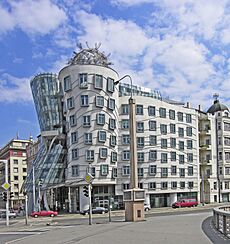
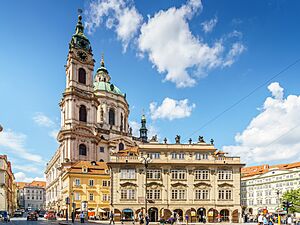
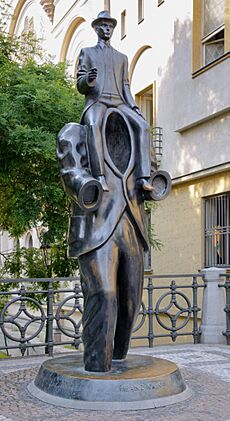
Since the fall of the Iron Curtain, Prague has become one of the world's most popular tourist spots. Prague was not damaged much during World War II. This means most of its historic buildings are still original. It has a beautiful mix of architectural styles. You can see Romanesque, Gothic, Renaissance, Baroque, and modern buildings.
Prague is a top global city. In 2016, it was ranked sixth on Tripadvisor's list of best destinations. Over 8.4 million international visitors come each year. In 2017, Prague was the 7th best city for conference tourism.
Main Attractions in Prague
Hradčany and Lesser Town (Malá Strana)
- Prague Castle with the St. Vitus Cathedral. This is where the Czech Crown Jewels are kept.
- The Charles Bridge (Karlův most).
- The beautiful Baroque Saint Nicholas Church.
- Church of Our Lady Victorious and the Infant Jesus of Prague.
- Písek Gate, one of the last old city gates.
- Petřín Hill with Petřín Lookout Tower, a Mirror Maze, and the Petřín funicular.
- Lennon Wall, a wall covered in graffiti inspired by John Lennon.
- The Franz Kafka Museum.
- Kampa Island, an island with great views of the Charles Bridge.
- The Baroque Wallenstein Palace and its garden.
Old Town (Staré Město) and Josefov
- The Astronomical Clock (Orloj) on the Old Town City Hall.
- The Gothic Church of Our Lady before Týn (Kostel Matky Boží před Týnem) from the 1300s. It has 80-meter-high towers.
- Stone Bell House.
- The old Gothic Old New Synagogue (Staronová Synagoga) from 1270.
- Old Jewish Cemetery.
- Powder Tower (Prašná brána), a Gothic tower that was part of the old city gates.
- Spanish Synagogue with its detailed inside decorations.
- Old Town Square (Staroměstské náměstí) with Gothic and Baroque buildings.
- The Art Nouveau Municipal House, a major concert hall.
- Museum of Decorative Arts in Prague, with collections of glass, furniture, and textiles.
- Clam-Gallas Palace, a Baroque palace from 1713.
- Church of St. Martin in the Wall.
- Colloredo-Mansfeld Palace, known for its dance hall.
- St. Clement's Cathedral, Prague.
New Town (Nové Město)
- The busy and historic Wenceslas Square.
- The National Museum at the head of Wenceslas Square. It is the largest museum in the Czech Republic.
- The National Theatre, a beautiful building with a golden roof by the Vltava river.
- The unique deconstructivist Dancing House (Fred and Ginger Building).
- Charles Square, once the largest medieval square in Europe, now a park.
- The Emmaus monastery.
- The museum about the Heydrich assassination in the crypt of the Church of Saints Cyril and Methodius.
- Stiassny's Jubilee Synagogue is the largest in Prague.
- The Mucha Museum, showing the Art Nouveau works of Alphonse Mucha.
- Church of St. Apollinaire, Prague.
- Church of Saint Michael the Archangel in Prague.
- Church of the Assumption of the Virgin Mary and St. Charles the Great, Prague.
- Church of Our Lady on the Lawn.
- St. Wenceslas Church (Zderaz).
- St. Stephen's Church.
Vinohrady and Žižkov Areas
- National Monument in Vitkov with a large bronze statue of Jan Žižka in Vítkov Park, Žižkov.
- The neo-Gothic Church of St. Ludmila at Míru Square in Vinohrady.
- Žižkov Television Tower.
- New Jewish Cemetery in Olšany, where Franz Kafka is buried.
- The Roman Catholic Sacred Heart Church at Jiřího z Poděbrad Square.
- The grand buildings in Vinohrady with different styles like Neo-Renaissance and Art Nouveau.
Other Interesting Places
- Vyšehrad Castle with the Basilica of St Peter and St Paul and the oldest Rotunda of St. Martin.
- The Prague Metronome at Letná Park, a giant working metronome.
- Prague Zoo in Troja, ranked among the best zoos in the world.
- Industrial Palace, Křižík's Light fountain, and funfair Lunapark in Holešovice.
- Letohrádek Hvězda (Star Villa) in Liboc, a Renaissance villa shaped like a star.
- National Gallery in Prague with a large collection of Czech and international art.
- Opera performances at the National Theatre often have English subtitles.
- Anděl, a busy area with modern buildings and a shopping mall.
- The large Nusle Bridge, connecting New Town to Pankrác.
- Strahov Monastery, an old abbey from 1149 with a famous library.
- Hotel International Prague, a four-star hotel and cultural monument.
-
The Charles Bridge is a historic bridge from the 1300s.
-
Prague Castle is the biggest ancient castle in the world.
-
National Theatre offers opera, drama, and ballet.
-
National Monument on Vítkov Hill. The statue of Jan Žižka is the third largest bronze horse statue in the world.
Tourism Statistics
Prague is the most visited city in the Czech Republic. In 2023, over 7.4 million guests stayed overnight. Most of them (78.8%) were from other countries. The average stay for foreign visitors was 2.3 nights. Most foreign visitors came from:
| Rank | Country | 2023 | 2019 |
|---|---|---|---|
| Total | 7,442,614 | 6,803,741 | |
| 1 | 1,029,856 | 900,526 | |
| 2 | 424,346 | 511,950 | |
| 3 | 399,185 | 495,728 | |
| 4 | 369,868 | 310,966 | |
| 5 | 331,834 | 252,633 | |
| 6 | 324,696 | 335,101 | |
| 7 | 200,370 | 248,911 | |
| 8 | 198,134 | 170,305 | |
| 9 | 194,571 | 227,345 | |
| 10 | 162,753 | 148,520 | |
| 11 | 155,583 | 272,451 | |
| 12 | 151,259 | 132,500 | |
| 13 | 104,924 | 108,175 | |
| 23,517 | 392,968 | ||
| 63,253 | 309,299 |
In 2023, the most visited places in Prague were:
| Rank | Destination | Number of visitors (in thousands) |
|---|---|---|
| 1 | Prague Castle | 2,191.8 |
| 2 | Petřín funicular | 1,915.7 |
| 3 | Prague Zoo | 1,358.4 |
| 4 | Petřín Lookout Tower | 643.1 |
| 5 | Old Town Hall | 560.8 |
| 6 | Prague Botanical Garden | 412.9 |
| 7 | Mirror Maze on Petřín Hill | 378.5 |
| 8 | Království železnic Smíchov | 320.2 |
| 9 | Chairlift in Prague Zoo | 305.6 |
| 10 | Municipal House | 261.0 |
Education in Prague
Prague has nine public universities and thirty-six private universities. Some of them are:
Public Universities
- Charles University (UK) founded in 1348, the oldest university in Central Europe.
- Czech Technical University (ČVUT) founded in 1707.
- University of Chemistry and Technology (VŠCHT) founded in 1920.
- University of Economics (VŠE) founded in 1953.
- Czech University of Life Sciences Prague (ČZU) founded in 1906/1952.
- Czech Police Academy (PA ČR) founded in 1993.
Public Arts Academies
- Academy of Fine Arts (AVU) founded in 1800.
- Academy of Arts, Architecture and Design (VŠUP) founded in 1885.
- Academy of Performing Arts (AMU) founded in 1945.
Private Universities
- Jan Amos Komenský University (UJAK) founded in 2001.
- Metropolitan University Prague (MUP) founded in 2001.
- The University of Finance and Administration (VSFS) founded in 1999.
Largest Private Colleges
- University College of Business in Prague (VŠO) founded in 2000.
- University of Economics and Management (VŠEM) founded in 2001.
- College of Entrepreneurship and Law (VŠPP) founded in 2000.
- Institute of Hospitality Management (VŠH) founded in 1999.
- College of International and Public Relations Prague (VŠMVV) founded in 2001.
- CEVRO Institute (CEVRO) founded in 2005.
- Ambis College (AMBIS) founded in 1994.
- Medical College of Nursing (Vysoká škola zdravotnická) founded in 2005.
- Anglo-American University (AAVŠ) founded in 2000.
- University of New York in Prague (UNYP) founded in 1998.
International Institutions
- Instituto Camões
- Goethe-Institut
- Instituto Cervantes
- British Council
- Alliance Française and Institut Français
- Istituto Italiano di Cultura
- Adam Mickiewicz Institute and Polish Institute
Science and Research in Prague
Prague is a major center for research. It is home to 39 of the 54 institutes of the Czech Academy of Sciences. These include large ones like the Institute of Physics. It also has 10 public research institutes and four business incubators. Large hospitals like Motol University Hospital also do research.
In 2008, there were 13,000 researchers in Prague. This was 3% of Prague's working population. Money spent on research and development was €901.3 million.
Many well-known international companies have research centers in Prague. These include Siemens, Honeywell, Oracle, Microsoft, and Broadcom.
Prague was chosen to host the administration of the EU satellite navigation system, Galileo. It started its first services in 2016.
Getting Around Prague: Transport
As of 2017, most people in Prague use public transport (52%). Cars are used for 24.5% of journeys. Walking accounts for 22.4%.
Public Transportation System
Prague has a very good public transport system called Prague Integrated Transport (PID). It includes the Prague Metro (subway), trams, buses, commuter trains, funiculars, and ferries. Prague has one of the highest rates of public transport use in the world. It has 1.2 billion passenger journeys each year.
Prague has about 300 bus lines and 34 regular tram lines. Since 2022, trolleybus lines are also being added.
There are also three funiculars. One is on Petřín Hill, another on Mrázovka Hill, and a third at the Zoo in Troja.
The Prague tram system uses different types of trams. These include the old Tatra T3 and newer Škoda 15 T trams. About 400 trams are modernized T3 models.
The Prague tram system is the twelfth longest in the world (144 km/89 miles). It has 786 individual cars, which is the largest fleet in the world. It carries over 360 million passengers each year.
All public transport services use a common ticketing system. You can buy tickets for 30 or 90 minutes. Short-term tourist passes are available for 24 hours or 3 days. Longer tickets can be bought using the Lítačka smart card. Since August 2021, people up to age 14 and over 65 can use public transport for free.
The Prague Public Transport Company runs most services. Since 2005, ferries on the Vltava river are also part of the system. Taxi services are available from the street or special stands.
Prague Metro System
The Metro has three main lines: A (green), B (yellow), and C (red). It is 65 km (40 miles) long with 61 stations. A fourth line, line D, is being built. It will connect the city center to southern parts.
The Prague Metro served 589.2 million passengers in 2012. This makes it the fifth busiest metro system in Europe. The first part of the Metro opened in 1974.
In April 2015, the green line A was extended. It now goes closer to the airport. The deepest station is Náměstí Míru. It has the longest escalator in the European Union. The Prague Metro is considered very safe.
Roads in Prague
Traffic mainly goes through the city center. It also uses inner and outer ring roads.
- Inner Ring Road (The City Ring "MO"): This road goes around central Prague. It includes the longest city tunnel in Europe, which is 5.5 km (3.4 miles) long. This tunnel, called Blanka tunnel complex, helps reduce traffic in the northwest. It opened in 2015.
- Outer Ring Road (The Prague Ring "D0"): This road will connect all major highways around Prague. It will allow faster travel without driving through the city. About 39 km (24 miles) of the planned 83 km (52 miles) are open. The southern part opened in 2010.
Rail Travel in Prague
Prague is the center of the Czech railway system. Trains go to all parts of the country and other countries. You can reach major European cities directly from Prague. These include Dresden, Berlin, Vienna, and Warsaw.
Prague's main international train station is Hlavní nádraží. Other main stations include Masarykovo nádraží and Holešovice. Commuter trains run under the name Esko Praha.
Air Travel in Prague
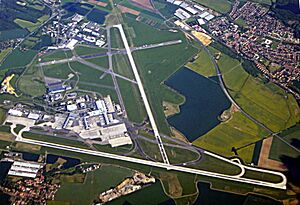
Prague is served by Václav Havel Airport Prague. It is the largest airport in the Czech Republic. It is also one of the busiest in Central and Eastern Europe. The airport is a hub for airlines like Smartwings and Czech Airlines.
Other airports in Prague include Kbely. This was the city's original airport. It is used by the Czech Air Force. It also has the Prague Aviation Museum. Letňany Airport is mainly for private planes. Vodochody Airport is used for testing aircraft.
Cycling in Prague
In 2018, about 1–2.5% of people commuted by bike in Prague. Cycling is very popular for sports and fun. As of 2019, there were 194 km (121 miles) of protected bike paths. There were also 50 km (31 miles) of bike lanes.
As of 2024, four companies offer bike sharing in Prague: Rekola, Nextbike, Bolt, and Lime. Bike sharing is partly connected to public transportation.
Sports in Prague
Prague hosts many sports events. It has national stadiums and sports teams.
Sports Teams in Prague
- Sparta Prague (Czech First League) – football club
- Slavia Prague (Czech First League) – football club
- Bohemians 1905 (Czech First League) – football club
- Dukla Prague (Czech 2nd Football League) – football club
- Viktoria Žižkov (Czech 2nd Football League) – football club
- HC Sparta Praha (Czech Extraliga) – ice hockey club
- HC Slavia Praha (Czech 2nd Hockey League) – ice hockey club
- USK Praha (National Basketball League) – basketball club
- Prague Lions (European League of Football) – American football
- AK Markéta Praha (speedway club)
- PSK Olymp Praha (athletics club)
Stadiums and Arenas in Prague
- O2 Arena – the second largest ice hockey arena in Europe. It hosted the Ice Hockey World Championship in 2004 and 2015.
- Strahov Stadium – the largest stadium in the world.
- Fortuna Arena, a football stadium.
- I. ČLTK Prague, a tennis club.
- Markéta Stadium, for speedway and athletics.
- Stadion Juliska, for football and athletics.
- Gutovka – a sports area with a large concrete skatepark. It has the highest outdoor climbing wall in Central Europe.
Sports Events in Prague
- Prague International Marathon
- Prague Open – Tennis Tournament
- Prague Chess Festival
- Sparta Prague Open – Tennis Tournament
- Josef Odložil Memorial – athletics meeting
- World Ultimate Club Championships 2010
- Mystic SK8 Cup – World Cup of Skateboarding event.
Prague's International Connections

Prague has its own EU office in Brussels called Prague House.
U.S. President Barack Obama gave a speech in Prague in 2009. This led to the New START treaty with Russia, signed in Prague in 2010.
The annual Forum 2000 conference is held in Prague. It was started by former Czech President Václav Havel. Its goal is to find solutions for world problems. It also promotes democracy and supports civil society. Many important thinkers and leaders have attended.
Twin Towns and Sister Cities
Prague is connected with these cities:
 Berlin, Germany
Berlin, Germany Brussels, Belgium
Brussels, Belgium Chicago, United States
Chicago, United States Frankfurt am Main, Germany
Frankfurt am Main, Germany Hamburg, Germany
Hamburg, Germany Kyoto, Japan
Kyoto, Japan Miami-Dade County, United States
Miami-Dade County, United States Nuremberg, Germany
Nuremberg, Germany Phoenix, United States
Phoenix, United States Taipei, Taiwan
Taipei, Taiwan
Places Named After Prague
Many other places around the world are named after Prague. This is often because Czech people moved there. You can find them especially in the New World.
|
Also, Kłodzko is sometimes called "Little Prague." It is now in Poland, but it used to be part of Bohemia.
|
See also
 In Spanish: Praga para niños
In Spanish: Praga para niños


